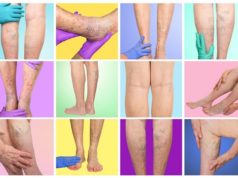 Members of the venous community have had a longstanding commitment to collecting and analysing the outcomes of venous procedures. The Vascular Quality Initiative (VQI) Varicose Vein Registry (VVR) grew out of a previous registry established by the American Venous forum, and is a joint initiative of the American Venous Forum and the Society for Vascular Surgery, write Nicholas Osborne, Danielle Sutzko, Andrea Obi, and Thomas Wakefield, Ann Arbor, USA.
Members of the venous community have had a longstanding commitment to collecting and analysing the outcomes of venous procedures. The Vascular Quality Initiative (VQI) Varicose Vein Registry (VVR) grew out of a previous registry established by the American Venous forum, and is a joint initiative of the American Venous Forum and the Society for Vascular Surgery, write Nicholas Osborne, Danielle Sutzko, Andrea Obi, and Thomas Wakefield, Ann Arbor, USA.
The purpose of the VVR is to analyse procedural and follow-up data, benchmark outcomes regionally and nationally for continuous improvement, develop best practices, and help meet Intersocietal Accreditation Commission (IAC) certification requirements for vein centres. Inclusion criteria include percutaneous (closed) and/or cutdown (open) procedures to ablate or remove superficial truncal veins, perforating veins or varicose vein clusters in the lower extremity (C2 or greater venous disease by the clinical CEAP classification). Exclusion criteria include any treatment of deep veins of the lower extremity, any intervention done for trauma, and treatment of C0 or C1 disease. The VVR is one of the 13 modules of the VQI. There are currently 444 centres in the VQI, in 46 US states and in Canada, with 18 regional quality groups. There are over 420,000 entries in all the registries combined (as of 01/11/2017) and over 16,000 in the VVR, ranking it seventh of all the registries as far as the number of procedures entered. The benefit of the VVR lies not only in its utility for quality initiatives, but as a tool to establish the effectiveness of various treatments.
The VVR offers rich clinical data that can be used to answer relevant research questions. We have now published three studies within the VVR. The first analysis examined the initial 10 months of the registry and established the utility of the registry to demonstrate patient improvement following treatment. There was a total of 1,406 patients, mean age 55 years, 72% female, with a mean BMI of 29. Caucasians made up 78% of the group, while African Americans made up 7%. Approximately one-third of the patients had previous varicose vein treatment, 7% had a history of deep vein thrombosis (DVT), and 8% were on anticoagulation; 2,661 veins were treated on 1,803 limbs with 1,751 procedures (either in office or operating room). Laterality was equally distributed between the right (48%) and left (49%), with a small number undergoing bilateral procedures (3%). Endovenous treatment of axial reflux was the preferred treatment in 89%, divided largely between radiofrequency ablation (55%) and endovenous laser ablation (34%). Clusters were often treated concomitantly with truncal reflux (76%). In this study, there was significant improvement in C class, venous clinical severity score (VCSS) of -4.68±3.35 and seven different components of the patient-reported outcome score including leg heaviness, achiness, swelling, throbbing, itching, appearance and work impact between pre-procedure and post-procedure, total score -10.8±6.9.1
In the second study, we used the robust data from the VVR to answer a clinically relevant question—do patients 65 years of age and older (who are Medicare-eligible) benefit from venous procedures? We identified 2,691 patients less than 65 years of age with 3,631 limbs undergoing 3,441 procedures, and 1,068 over 65 years of age with 1,467 limbs undergoing 1,400 procedures. There were statistically less Caucasians in the younger group and a greater number of females. The younger group had a statistically significant higher BMI, a smaller number of patients with a history of bilateral varicose vein treatments, and a smaller number of younger patients who were on chronic anticoagulation (5%) compared to older patients (16%). Both groups demonstrated a statistically significant improvement in VCSS and patient-reported outcomes, with equivalent improvements in VCSS scores pre to post-procedure. Younger patients showed more improvement in patient-reported outcomes but were also more likely to undergo combined procedures, as compared to the older group. Complication rates were equivalent between the groups with the exception of a higher wound infection rate in the older group, although the overall infection rate was low in both groups.2
Finally, in our most recent analysis, we examined the outcomes of geriatric patients (age greater than 80 years). For this analysis, we looked at the patients less than 65 years of age, those 65 to 79 years of age, and then the group ≥80 years old. In total 4,043 patients <65 years of age underwent 8,608 procedures; 1,334 patients between 65 and 79 years of age underwent 3,226 procedures; and 161 patients ≥80 years of age underwent 428 procedures. Patients in the ≥80 group had an overall lower average BMI, were more likely to be on anticoagulation and undergo truncal procedures alone compared to the other groups. The oldest group had more procedures performed for patients with C6 (active venous ulceration) compared to the younger age groups. Over 64% underwent a truncal procedure only in the group ≥80 years of age, while in the younger patients, the proportion undergoing truncal and truncal plus cluster procedures was fairly equal. In all groups, VCSS improved equivalently, while the youngest group had the most improvement in patient-reported outcome at 10.6, the middle group improvement of 9.6, and the oldest group improvement of 8.8. With regards to octogenarians with active ulceration or C6 disease, 55% of procedures (n=29) with post procedure follow-up resulted in a healed ulcer. Complication rates were low amongst all age groups.3
These three studies underscore the utility of the VVR not only as a research tool, but as a tool to help guide decision-making at the patient and policy level. For instance, these data clearly show the benefit of operative treatment of superficial venous disease in the elderly based on objective, provider generated criteria and patient-reported outcomes. Such information support coverage decisions for Medicare-eligible patients. The VQI VVR has combined a vast number of procedures performed by various providers across regions and serves as an enriched data source for many potential research questions that cannot be answered at a single institution. We urge all centres performing varicose vein procedures to join the registry, to track and compare their results to other centres in their region and in the country, and utilise the database to ensure quality improvement.
Nicholas Osborne, Danielle Sutzko, Andrea Obi, and Thomas Wakefield are with University of Michigan, Ann Arbor, USA
References
1. Obi, AT, et al, First 10-month results of the Vascular Quality Initiative Varicose Vein Registry. J Vasc Surg Venous Lymphat Disord 2017. 5(3): p312–20 e2.
2. Sutzko, DC, et al, Age is not a barrier to good outcomes after varicose vein procedures. J Vasc Surg Venous Lymphat Disord 2017. 5(5): p647–57 e1.
3. Sutzko DC, OA, Kimball AS, Smith ME, Wakefield TW, Osborne NO, Clinical outcomes after varicose vein procedures in octagenarians within the vascular quality initiative varicose vein registry. J Vasc Surg Venous Lymphat Disord (In Press).








